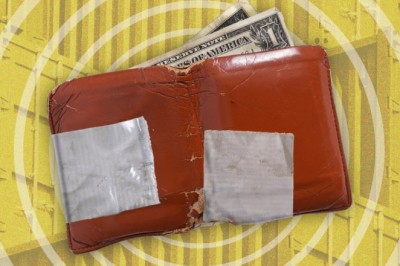
- Latest
- Watchlist
- Markets
- Investing
- Personal Finance
- Economy
- Retirement
- How to Invest
- Video Center
- Live Events
- MarketWatch Picks
- More Latest Watchlist Markets Investing Personal Finance Economy Retirement How to Invest Video Center Live Events MarketWatch Picks
Advertisement
- Home
- Picks
- Investing
- The Advicer
MarketWatch Picks has highlighted these products and services because we think readers will find them useful; the MarketWatch News staff is not involved in creating this content. Links in this content may result in us earning a commission, but our recommendations are independent of any compensation that we may receive. Learn more
Question: Two years ago my husband took an early retirement when offered by his company. At that time we had a 401(k) with about $550,000 that we gave to a big financial services firm rep to handle. Since then we’ve lost $88,000 due to poor market conditions and decisions. We expressed our need for a conservative approach. A large portion is tied up in bonds and that amount feels like way too much to lose!
What’s worse, the agent keeps telling us that our $4,750 per month draw is too much. Do we change agents within the company? Jump ship and transfer everything to another company? Do we have to live on less than we want to just to make up for the loss? (Looking for a financial adviser too? This tool can help match you with an adviser who might meet your needs.)
Answer: There are a few questions to ask here: First, is your withdrawal rate reasonable; second did your adviser do you wrong with those big losses; and third, what do you do about the adviser situation?
Your withdrawal rate is a big issue — and on that your adviser has a point. “A $4,750 monthly withdrawal equals approximately a 10% withdrawal rate from your portfolio. The generally-accepted withdrawal rate in retirement is around 4%, meaning you’re withdrawing more than double what is generally considered a safe amount,” says certified financial planner Taylor Jessee at Impact Financial. In fact, certified financial planner Jim Hemphill at TGS Advisors says this is “absurdly, unsustainably high, unless you both retired well into your 80s. We know that’s not the case since you took an early retirement.”
Have an issue with your financial adviser or looking for a new one? Email picks@marketwatch.com.
Think about it this way: With a 10% withdrawal rate, your portfolio needs to earn at least 10% for you to break even, otherwise you’re dipping into the principal. “Historically, the stock market returns about 9% per year but most retired couples’ portfolios are not 100% invested in stocks, meaning a retired couple usually shouldn’t expect to earn the stock market average. A diversified portfolio may earn around 5% to 6% on average, so if you’re withdrawing 10% per year from the portfolio, you can see how the math would start to work against you really quickly,” says Jessee. (Looking for a financial adviser too? This tool can help match you with an adviser who might meet your needs.)
Indeed, Hemphill says you have to live on less than you want because what you want is unrealistic. “Not because of market conditions, because returns don’t exist that will support a 10% plus distribution rate,” says Hemphill
For his part, certified financial planner Derieck Hodges at Anchor Pointe Wealth says longevity becomes a concern with the withdrawal you’re taking. “Decreasing your balance each year may not be a concern if you’re in your 70s or 80s, but it may imperil your future financial security if you’re younger. Evaluating your spending and withdrawal needs is wise,” says Hodges. What’s more, if you can reduce your distribution during this challenging investment market, it will likely bolster your financial security, according to Hodges.
Next let’s look at those losses: Is $88,000 of a $550,000 portfolio too much to lose, especially considering you asked for a conservative approach? According to these figures, you lost roughly 16%, which is actually less than the U.S. stock market was down overall (as of the writing of this letter), but slightly higher than the overall bond market. Your adviser likely thought bonds would be a solid investment, but last year was a tough one for both bonds and stocks.
“When it comes to investing, both in stocks and bonds, it should be expected that your portfolio will go up and down. Historically, it tends to go up much more than it goes down, but last year happened to be a year when it was down,” says Jessee.
That said, you should also review your mix of investments and evaluate the historical returns compared to an appropriate benchmark. “If you like a blend of 60% stocks and 40% bonds, don’t compare your investment results to the S&P 500, which is 100% stocks. Instead, use an index like the Morningstar US Moderate Target Allocation to evaluate under or over-performance,” says Hodges.
Going forward, you’ll want to evaluate your age, health, likely longevity and future spending needs. “How much investment risk can you tolerate? Lower risk tolerance investments produce lower investment returns. Can you accomplish your financial goals with those small returns? Don’t evaluate risk and return by only considering recent history, you need to take a longer view,” says Hodges.
Most importantly, don’t panic or make rash decisions. “Deliberately keep evaluating your needs, goals and desires and remember that 2022 was painful for virtually every investor, even those owning quality, diversified investments,” says Hodges.
Should you get a new adviser? It could be worth considering, as the communication seems iffy in this relationship. Indeed, the adviser doesn’t seem to have clearly communicated the issues with your withdrawal rate or why your losses were so high. And you may have to consider other options too that an adviser could give advice on, should you go that route. For example, “One or both of you may need to go back to work,” says Hemphill. (Looking for a financial adviser too? This tool can help match you with an adviser who might meet your needs.)
To search for credentialed advisers, you may want to visit the National Association of Personal Financial Advisors (NAPFA) or XY Planning Network, where you can use a tool to find planners with the CFP designation and certain specialties.
Have an issue with your financial adviser or looking for a new one? Email picks@marketwatch.com.
Questions edited for brevity and clarity.
The advice, recommendations or rankings expressed in this article are those of MarketWatch Picks, and have not been reviewed or endorsed by our commercial partners.
"“I hope the way you spend your money is in line with the truth of who you are and what you care about," she says.
Alisa Wolfson is a reporter for MarketWatch Picks.
Copyright © 2023 MarketWatch, Inc. All rights reserved.Subscriber Agreement & Terms of Use | Privacy Notice | Cookie NoticeMarketWatch
- Customer Center
- Contact Us
- Newsroom Roster
- Virtual Stock Exchange
- BigCharts
- Copyright Policy
- Manage Notifications
- Cancel My Subscription
Company
- Dow Jones
- Code of Conduct
- Corrections
- Reprints & Licensing
- Digital Self Service
- Your Ad Choices
- Corporate Subscriptions
- Accessibility
- All News
Articles
Video
Podcasts
Authors
Sections
Columns
Symbols
Private Companies
Recently Viewed Tickers
No Recent Tickers
Visit a quote page and your recently viewed tickers will be displayed here.














Comments
0 comment